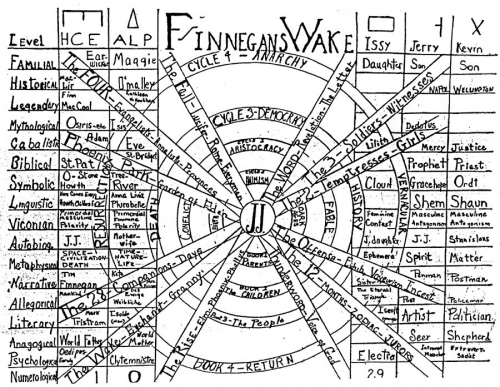Finnegans Wake, fascism, and the essential unity of the human race

Sean Ledwith shows how Finnegans Wake, far from being an incomprehensible waste of Joyce's genius, is an anti-fascist masterwork, uniting and celebrating the wholeness, richness and vibrancy of human culture
80 years ago, as the clouds of war darkened over Europe, one of the most notoriously baffling books of all time was published in Paris. From the moment of its release, James Joyce’s Finnegans Wake acquired the reputation in many quarters of being not only baffling in content but also utterly unreadable in form. The first sentence alone often proves an insurmountable hurdle for many readers inclined to attempt to conquer this Himalayan peak of modern literature:
riverrun, past Eve and Adam’s, from swerve of shore to bend of bay, brings us by a commodious vicus of recirculation back to Howth Castle and Environs.
Another 600 or so pages jammed with the same apparently random smorgasbord of portmanteau words, puns, incomprehensible allusions and dearth of narrative signposts is understandably unappealing on first inspection. The book was dismissed even by some of Joyce’s most loyal supporters who had hailed Ulysses in the 1920s as the masterpiece of the century.
Three of the most important advocates of that work denounced its follow-up as a criminal waste of Joyce’s undoubted genius. The poet Ezra Pound, publisher Harriet Weaver and Joyce’s brother Stanislaus all played key roles in securing the tortuous passage of Ulysses through the publication process, often in the teeth of aggressive opposition from the literary and social establishment of the day. All three, however, ultimately became estranged from the author due to their negative reactions to the Wake. HG Wells was another prominent supporter of Joyce left nonplussed by Finnegans Wake and who expressed his reservations directly to the author:
I don't think it gets anywhere. You have turned your back on common men — on their elementary needs and their restricted time and intelligence... What is the result? Vast riddles. Your last two works have been more amusing and exciting to write than they will ever be to read. Take me as a typical common reader. Do I get much pleasure from this work? ... No.
As a man of the left, Wells’ criticism also suggests that any social and political critique that might have been contained in Joyce’s previous oeuvre was entirely absent from the Wake and therefore the book has nothing meaningful to say about politics or society and represented pure self-indulgence on the part of the author. Wells’ judgement probably still reflects the consensus for most as Joyce’s final work is often cited as one of the greatest novels most people will never read.
Radical and subversive traditions
However, the 80th anniversary of Finnegans Wake is a suitable time to revisit the book and question both the notions that it is unreadable and that it has nothing to say about the world. In fact, a small number of commentators over the years have indicated that not only should the Wake be viewed alongside Ulysses as an indispensable part of the modernist canon, but the book actually draws its creative impulses from some of the most radical and subversive traditions in the West. One of the best commentators on the Wake, Bernard Benstock even goes as far as to suggest:
The political climate of ‘Finnegans Wake’ owes as much to fundamental Marxian dialectics as its psychological climate is dependent upon Freud and Jung and its evolutionary structure determined by Darwin. There is no reason to assume that Joyce was a Marxist but it is important to realise that Joyce was aware of the various political aspects of contemporary society spotlighted by Marx’s sociological perspective.
Benstock also draws attention to the fact that the Wake’s publication on the eve of WW2 is not incidental and that Joyce wished, in his own idiosyncratic style, to express his views on the rise of fascism that he had witnessed in Italy and France at close-quarters as part as long-term exile from his native Ireland. One year after completion of the work, Joyce was forced to flee France as the Wehrmacht launched its devastating blitzkrieg across the country, culminating with Panzers rolling through the streets of Paris that Joyce had regarded as home for almost twenty years. His record of helping Jewish families escape from Austria and Germany before the war is little known but dispels the myth that he was an apolitical figure in the 1930s, disinterested in the course of European politics. Using his contacts in the French and Irish ministries, Joyce arranged life-saving visas for scores of refugees fleeing the Nazi menace.

James Joyce and Paul Léon
Paul Leon, one of Joyce’s closest supporters who defended the Wake, was arrested by the Gestapo due to his Jewish heritage and perished in Auschwitz in 1942. In his last months, Joyce fretted over the fate of his daughter Lucia, who due to chronic mental health problems was languishing in a sanatorium in Brittany. He would have known all too well the grim consequences that awaited such patients in the event of Nazi occupation. Even the muted welcome of the Wake itself was partly affected by Joyce’s revulsion against fascism. The American poet Ezra Pound, although a great advocate of Ulysses in the 1920s, was an unashamed supporter of Mussolini and Hitler by the time Joyce commenced work on the Wake. The differences between the two authors were not purely artistic.
It would be an absurd case of reductionism, of course, to present the Wake as primarily an anti-fascist tract, but Bernard Benstock persuasively makes the case that Joyce regarded himself as the equivalent of the Irish monks who, at the onset of the Dark Ages of the early medieval period, sought to preserve the culture of the classical world as the forces of barbarism and darkness, in their eyes, closed in on civilisation. The astonishing breadth of allusions and references from the cultures of the world that Joyce draws on in the Wake is testament to his conviction that diversity and pluralism are essential to the flourishing of human beings and, implicitly, that the intolerance and racism of the far right represent a modern barbarism which must be resisted. One of the most celebrated (and accessible) sections of the book, the Anna Livia Plurabelle passage, rhapsodises on the richness and vibrancy of the tapestry of human societies over millennia:
In the name of Annah the Allmaziful, the Everliving, the Bringer of Plurabilities, haloed be her eve, her singtime sung, her rill be run, unhemmed as it is uneven!
A clarion call for multiculturalism
Incredibly, phrases and vocabulary from some seventy languages have been identified in the book, along with a cornucopia of references to virtually all the major world religions, including Confucianism, Hinduism, Taoism and the Eddas of Scandinavia. Joyce had memorably chronicled his own loss of religious faith in Portrait of the Artist as a Young Man, published in 1902,but he never lost an appreciation of the importance of ritual and spirituality for millions around the world and would have been keenly aware of how the Nazis aspired to eradicate supposedly non-Aryan forms of belief.
Another one of the great scholars of the Wake, James Atherton, contends Joyce used the Koran, for example, as ubiquitously as a telephone directory, and incorporated the suras, or chapters, of Islam’s holy book throughout the text. As a major European writer in the first half of the twentieth century researching and utilising in depth a plethora of non-Western culture, Joyce has no equal. Even in our time, as Islamophobia permeates the ideology of the far right, Joyce’s willingness to absorb the vitality of other cultures stands out as exemplary. The fact that Joyce, who was practically blind by 1939, chose to deploy his encyclopaedic and labyrinthine knowledge of the varieties of human belief in such a gargantuan exercise can be seen as a heroic act of defiance in the face of an oncoming nightmare. It is not unreasonable to argue that Finnegans Wake is the ultimate literary clarion call for what we now call multiculturalism.
Benstock’s case that the left-wing credentials of the Wake have been neglected for too long also rests on Joyce’s use of two philosophers who can be seen as progenitors of the tradition of historical materialism and antecedents of Hegel and Marx. The ideas of the eighteenth century Italian thinker, Giambattisto Vico, are integral to the Wake – as evident in the book’s first sentence. He was one of the first philosophers to work towards a materialist philosophy of history, which did not perceive events as the unfolding of some form of plan based on the will of unseen but all-seeing deities. Vico devised a cyclical version of history, comprising of three epochs – the divine, the heroic and the human, climaxing with what he termed a ricorso, or reversion back to the beginning. Famously, the last sentence of the Wake links back to the first in a satisfying completion of the Viconian cycle: A way a lone a last a loved a long the.....

Giambattisto Vico
Contrary to the view that the Wake is an incoherent and rambling mess, the four sections of the work loosely follow this scheme – albeit, with typical Joycean mischief, in reverse! Samuel Beckett, friend and collaborator of Joyce, in one of the earliest interpretations of the Wake argued the author’s appropriation of Vico symbolises an individual’s journey through belief, marriage and burial. Benstock, however, makes the case that Vico’s four stages are a historic first draft of Marx’s outline that humanity progresses through modes of production, climaxing with communism. The great author of Capital himself was not unaware of the role Vico played in paving the way for historical materialism:
Darwin has interested us in the history of Nature's Technology, i.e., in the formation of the organs of plants and animals, which organs serve as instruments of production for sustaining life. Does not the history of the productive organs of man, of organs that are the material basis of all social organisation, deserve equal attention? And would not such a history be easier to compile, since, as Vico says, human history differs from natural history in this, that we have made the former, but not the latter?
Trotsky also begins his epic history of the Russian Revolution with a reference to Vico’s ideas.
The other major conceptual underpinning of the Wake is provided by Giordano Bruno, the sixteenth century Italian astronomer and philosopher who was executed by the Catholic Church for his heretical ideas on heliocentrism. More important for Joyce, however, was Bruno’s radical views on the unity of opposites and the limitations of dualism, which are impossible to study now without being reminded of similar ideas in the Hegelian dialectic. In a work from 1584, Bruno writes:
...even in the two extremes of the scale of nature, we contemplate two principles which are one; two beings which are one; two contraries which are harmonious and the same. Therefore height is depth, the abyss is light unvisited, darkness is brilliant, the large is small, the confused is distinct, dispute is friendship, the dividend is united, the atom is immensity.... Here are the signs and proofs whereby we see that contraries do truly concur; they are from a single origin and are in truth and substance one.
The emphasis on the importance of assimilation and synthesis in the thought of Bruno is adapted in the Wake in the form of numerous dualistic personality clashes between archetypes broadly representing the artistic and scientific mentalities. The dialogues between the brothers Shem and Shaun, St. Patrick and the Arch Druid, Mutt and Jutte, the Ant and the Grasshopper and many others throughout the book play out the contests between ideologies, nations and classes which have driven human history forwards. The dialectical power of these discussions, which Hegel and Marx would have appreciated, is revealed as no participant decisively emerges victorious and that, in the unfolding spiral of social development, everyone and everything contributes in some form. Alternatively, as Joyce in his inimitable way puts in the Wake:
a clappercoupling smeltingworks exprogressive process, (for the farmer, his son and their homely codes, known as eggburst, eggblend, eggburial and hatch-as-hatch can) receives through a portal vein the dialytically separated elements of prededent decomposition for the verypet-purpose of subsequent recombination so that the heroticisms, catastrophes and eccentricities transmitted by the ancient legacy of the past….
Joyce’s desire in the Wake to conserve the best elements of human civilisation is focused not only on identifying the cultural artefacts that have evolved over centuries, such as languages and religions, but also on those fields of enquiry that were emerging in his own lifetime. In the 1930s, relativity and quantum theory represented the most trailblazing branches of scientific discovery, and sections of the book clearly indicate that Joyce appreciated the revolutionary implications of these areas in terms of our understanding of the world. Einstein’s seminal notion that space and time are not separate categories but form a unified space-time continuum that shapes the universe is one of the other dualities that Joyce undermines. The author’s awareness of the transformative nature of Einstein’s view, of course, is in stark contrast to that of the Nazis who drove the great physicist, along with many of his Jewish colleagues, out of Germany:
And let every crisscouple be so crosscomplimentary, little eggons, youlk and meek, in a farbiger pancosmos.
Joyce’s appreciation of Theoretical Physics was famously reciprocated in 1963 when Murray Gell-Man turned to the Wake to name a newly discovered elementary particle of matter that is smaller than a proton or a neutron. Hence the ‘quark’ was born!
Barely any aspect of human activity is overlooked in the Wake. In one memorable passage, Joyce utilises the names of some of the finest cricketers of the age, alongside some of that sport’s distinctive jargon. The book incorporates numerous devices and techniques that were being pioneered in the contemporary worlds of advertising, cinema and television, such as montage and sloganeering. Joyce’s disdain for the elitist differentiation between high and low culture, and his preference for emerging ‘democratic’ art forms, is even apparent in the book’s title, which is taken from a popular American ballad.
A rallying call for revolution
In the light of all these elements being conjoined in a single text, it is difficult to think of any other artistic enterprise created by one person that so spectacularly illustrates the concept of totality, as understood by Marxist philosophers such as Gramsci and Lukacs. Benstock and other left-wing commentators have interpreted the climax of the book as a rallying call for revolution as HCE, the key protagonist, experiences a personal paradigm-shift that mirrors the transfigurative nature of political upheaval. Typically, Joyce utilises the vocabulary of Asiatic mythology to articulate this leap into the future:
Sandhyas! Sandhyas! Sandhyas! Calling all downs. Calling all downs to dayne. Array! Surrec-tion! Eireweeker to the wohld bludyn world. O rally, O rally, O rally! Phlenxty, O rally! To what lifelike thyne of the bird can be.
The supposedly unreadable nature of the work is partly a linguistic consequence of this attempt to compress the essence of humanity into a single document that acknowledges the multitudinous achievements, failures and ideas of our collective experience as a species. For potential readers who have avoided the Wake so far, it might be worth considering that in the age of the internet, the book is actually far more accessible now than it was at the time of first publication.
Joyce’s breath-taking erudition can now be followed and tracked much more conveniently than for the first generation of readers. In that sense, it is a work for the 21st century even more than the 20th. Similarly, it could be argued that only in the globalised and hybrid era of late capitalism in which we are now situated is it possible to fully appreciate the grandeur and scope of Finnegans Wake. The book is a remarkable instancing of the emerging spirit of cosmopolitanism and a powerful riposte to narrow nationalism and chauvinism, both in Joyce’s time and ours.
The author himself also demonstrated the best way to approach the Wake is to read it aloud, as a lot of the subterranean allusions and nuances of the text emerge more noticeably in arguably the original art form of human beings – oral story-telling.
There is no evidence that Joyce was aware of Gramsci’s work (perhaps unsurprising in light of the latter’s incarceration in the 1930s) but Finnegans Wake is an unwitting monument to the great Italian Marxist‘s belief that our historical development, if permitted by a suitable course of events, will facilitate the cultural unification of the human race. Not in the sense of imposing uniformity but in the sense of recognising the commonality of experiences and beliefs that have driven men and women over millennia, and culminating in a new age of universal tolerance.
To conclude: an understanding of the historical and ideological ingredients of the Wake indicates that early sceptics such as Wells and Pound could not have been more wrong. As fascism rears in hideous head again in our time, with its visceral politics of hate, the message of the Wake about the essential unity of the human race is emphatically worth another look.

Sean Ledwith
Sean Ledwith is a Counterfire member and Lecturer in History at York College, where he is also a UCU branch rep.
